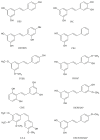The Interplay Between Autophagy and Apoptosis in the Mechanisms of Action of Stilbenes in Cancer Cells
- PMID: 40227400
- PMCID: PMC11939748
- DOI: 10.3390/antiox14030339
The Interplay Between Autophagy and Apoptosis in the Mechanisms of Action of Stilbenes in Cancer Cells
Abstract
Plant-based stilbenes are low-molecular-weight polyphenolic compounds that exhibit anti-oxidant, anti-microbial, anti-fungal, anti-inflammatory, anti-diabetic, cardioprotective, neuroprotective, and anti-cancer activities. They are phytoalexins produced in diverse plant species in response to stress, such as fungal and bacterial infections or excessive UV irradiation. Plant-derived dietary products containing stilbenes are common components of the human diet. Stilbenes appear to be promising chemopreventive and chemotherapeutic agents. Accumulating evidence indicates that stilbenes are able to trigger both apoptotic and autophagic molecular pathways in many human cancer cell lines. Of note, the molecular crosstalk between autophagy and apoptosis under cellular stress conditions determines the cell fate. The autophagy and apoptosis relationship is complex and depends on the cellular context, e.g., cell type and cellular stress level. Apoptosis is a type of regulated cell death, whereas autophagy may act as a pro-survival or pro-death mechanism depending on the context. The interplay between autophagy and apoptosis may have an important impact on chemotherapy efficiency. This review focuses on the in vitro effects of stilbenes in different human cancer cell lines concerning the interplay between autophagy and apoptosis.
Keywords: apoptosis; autophagy; cancer cells; cell death; piceatannol; polyphenols; pterostilbene; resveratrol; stilbenes; stilbenoids.
Conflict of interest statement
The authors declare no conflicts of interest.
Figures







Similar articles
-
Biological actions and molecular effects of resveratrol, pterostilbene, and 3'-hydroxypterostilbene.J Food Drug Anal. 2017 Jan;25(1):134-147. doi: 10.1016/j.jfda.2016.07.004. Epub 2016 Sep 22. J Food Drug Anal. 2017. PMID: 28911531 Free PMC article. Review.
-
Biological Activities of Stilbenoids.Int J Mol Sci. 2018 Mar 9;19(3):792. doi: 10.3390/ijms19030792. Int J Mol Sci. 2018. PMID: 29522491 Free PMC article. Review.
-
Plant stilbenes induce endoplasmic reticulum stress and their anti-cancer activity can be enhanced by inhibitors of autophagy.Exp Cell Res. 2015 Nov 15;339(1):147-53. doi: 10.1016/j.yexcr.2015.10.014. Epub 2015 Oct 17. Exp Cell Res. 2015. PMID: 26477823 Free PMC article.
-
Pro-autophagic polyphenols reduce the acetylation of cytoplasmic proteins.Cell Cycle. 2012 Oct 15;11(20):3851-60. doi: 10.4161/cc.22027. Cell Cycle. 2012. PMID: 23070521 Free PMC article.
-
Modulation of Autophagy in Cancer Cells by Dietary Polyphenols.Antioxidants (Basel). 2021 Jan 16;10(1):123. doi: 10.3390/antiox10010123. Antioxidants (Basel). 2021. PMID: 33467015 Free PMC article. Review.
References
-
- Shen T., Xie C.-F., Wang X.-N., Lou H.-X. Stilbenoids. In: Ramawat K., Mérillon J.-M., editors. Natural Produccts:Phytochemistry, Botany and Metabolism of Alkaloids, Phenolics and Terpenes. Springer Berlin Heidelberg; Berlin, Heidelberg: 2013. pp. 1901–1949.
-
- Gorham J. Biochemistry of the Stilbenoids. 1st ed. Springer; Dordrecht, The Netherlands: 1995.
-
- Niesen D.B., Hessler C., Seeram N.P. Beyond resveratrol: A review of natural stilbenoids identified from 2009–2013. J. Berry Res. 2013;3:181–196. doi: 10.3233/JBR-130062. - DOI
Publication types
LinkOut - more resources
Full Text Sources

